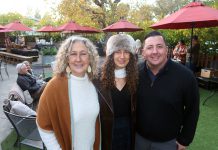The best month of all
May and October…two of my favorite months in Sonoma County…October for the start of the planting season for CA natives, and the quality of the light over the golden hills.
May for the flowers; the green hills, the poppies and other wildflowers, Pacific coast iris, the salvias, the fragrance of moist soil, the wonderful plant events…and more….
The soil is still damp and a thick layer of mulch will retain that moisture and inhibit most weed growth.
There are many types of mulch to choose from; so which ones are the best? As with anything else, it depends! Depends on the area to be mulched and the plants that grow there. Rich, well-composted organic product is always great, especially for the vegetable garden. Its dark brown appearance is attractive between salvias and other natives, especially those with gray-green leaves, as the contrast between the dark and the light is beautiful.
A shady woodland garden of ferns, wild ginger, heucheras or foamflowers or sugar scoops (Tiarella unifoliata) looks best if it’s natural, therefore mulched with chipped redwood bark or oak leaves, which have been chopped with a lawnmower. Very fine bark, shredded bark and sawdust tend to repel water, so any irrigation lines should be placed under the bark. Sawdust applied too thickly may compact and become impenetrable by water…additionally, it may become mildewy.
Dry chaparral areas become naturally mulched as the leaves drop to the ground. To cover the bare soil between plants, the addition of some gravel or shredded bark helps but the mulch should be on the thin side. Thick mulch holds moisture, which may lead to fungal growth.
Leaving some bare soil throughout the garden is beneficial to insects that nest in the ground. A very heavy mulch can deter the critters that need access to the soil…bumblebees are an example of a ground-nesting bee. Some bees nest in wood, so the addition of a few old logs is helpful. Imagine the appearance of the ground in woodlands, and you can get a feel for how we can reproduce some of that in our own gardens. A manicured look is attractive to many people, but not necessarily to the animal life that needs protecting.
Newspapers and cardboard, covered with attractive mulch, are an effective way to keep weed seeds from sprouting. They will last for several years and add to the fertility of the soil. Holes can be dug right through the paper to add plantings.
Straw is also a useful mulch and is inexpensive. Rice straw is best, as it contains few if any weed seeds, as does hay straw. Straw is flammable. The straw adds fiber to a heavy or sandy soil.
Gravel or crushed rocks conserve soil moisture and keep down weeds but do not add nutrition to the soil. Because of its rather sterile appearance, it is not particularly attractive except perhaps in rock gardens or around succulents or cacti.
Green grass clippings from lawn mowers should be first composted before using as mulch. Applied fresh, grass can mat and become slimy and compacted such that mildew may appear, or water cannot penetrate through it to the soil.
Pine needles are excellent to use around plants that like acidified soil, such as plants in the heather family.
Cocoa hulls are expensive and can blow around. They are pretty to look at and may smell pleasant for a short time. There are issues around their toxicity to some plants and perhaps to dogs. Best to use with caution!
California Native Plant Society’s meeting for May is on the 21st, Tuesday evening, at 7:30 pm. Meetings are held at Luther Burbank Art & Garden Ctr. at 2050 Yulupa Av. in Santa Rosa.
Ted Kipping will share his photos of the wildflowers of the Carson Pass area in the Sierra Nevada Mts. A great way to get ready for the summer!
Contact me at: jo*******@*****st.net. Have a flower-filled May!








